Seibert & Krafft Antique Brass Parallel Linkage C-pillar Microscope Circa 1875
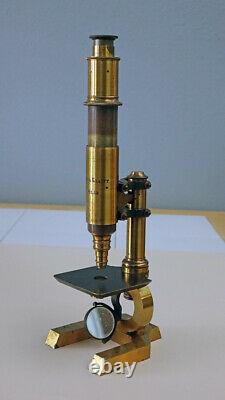
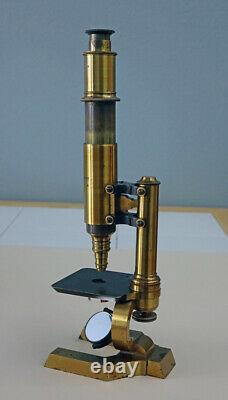
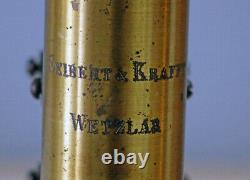
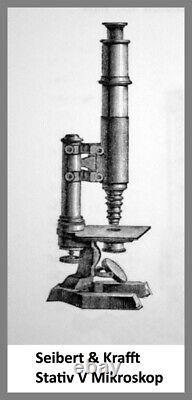
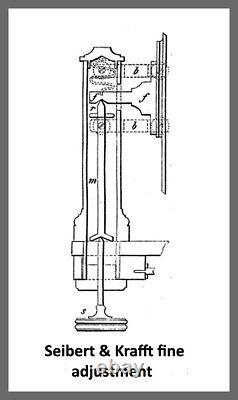
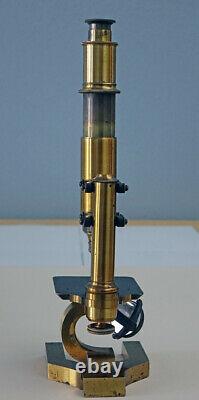

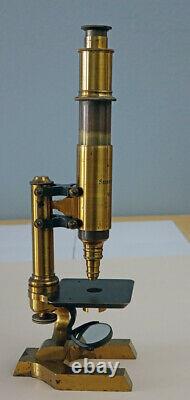
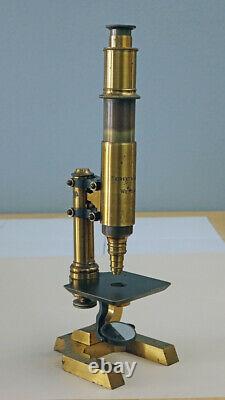


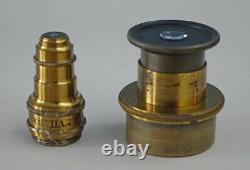

SEIBERT & KRAFFT ANTIQUE BRASS PARALLEL LINKAGE C-PILLAR MICROSCOPE - CIRCA 1875. SEIBERT & KRAFFT ANTIQUE BRASS PARALELL LINKAGE C PILLAR STATIV V MICROSCOPE CIRCA 1875.
This instrument is built upon their Stativ V or Stand V and is virtually the same microscope stand that was originally designed by their immediate predecessor, Ernst Gundlach, before he abruptly departed Germany for the USA in 1872 Note: The brothers Siebert worked for Gundlach for a time before he left Germany for the USA. Please see the detailed history below.
This instrument is signed on the face of the brass sleeve that holds the body tube, SEIBERT & KRAFFT, WETZLAR. This signature is indicative of the relatively brief 12-year period between 1872 and 1884 when the brothers Seibert were involved in a business relationship with George Krafft, a Wetzlar businessman, to produce microscopes many of which were based on the designs of Ernst Gundlach. Thus, all microscopes bearing the Siebert & Krafft moniker are quite rare. This instrument lacks a typical serial number.
Ultimately, after the business partnership with George Krafft dissolved, the W. Seibert optical firm, following the general practice of many other contemporary German optical firms, engraved the serial numbers of its instruments into the lip of the wood case that housed the instrument. In this case, we do not have the original wood case that came with the instrument.
So, we do not have the serial number of this microscope as an aid in dating the instrument. However, based on its overall design that virtually duplicates Stand V by Gundlach combined with the way that it is signed, i. SEIBERT & KRAFFT, WETZLAR, we can confidently date the instrument to circa 1875.
NOTE: For more details on the history of the Seibert & Krafft of Wetzlar optical firm along with the W. Seibert optical firm that ultimately emerged from this relationship, please see below. Accompanying this listing is an illustration of this model microscope extracted from my personal library copy of the 1877 publication entitled, Das Mikroskope Theorie Und Anwendung Desselben by Carl Nageli and S.
Schwendener as published by Verlag Von Wilhelm Engelmann in Leipzig. The similarities to the listed instrument are readily apparent.
This instrument features an unusual fine focus adjustment mechanism that is located under the stage of the microscope. This system was described in detail in the Journal Of The Royal Microscopical Society (JRMS), Volume III, Part 2 (1880) on pages 1047 and 1048 under the title, Seibert and Kraffts Fine Adjustment. Accompanying this listing is a sectional diagram of this mechanism that was included with the JRMS article (Note: Please see below for more details on this fine focus mechanism). NOTE: As an added bonus, a complete copy of the JRMS article will be provided to the purchaser of this instrument. This outstanding all brass microscope by Seibert & Krafft of Wetzlar will make a very nice addition to any microscope collection, especially one that specializes in the beautiful hand crafted instruments made by the very talented German opticians of the 19th Century. It also represents a snapshot in the history of the development of the microscope that is certain to be of special interest to the astute antique microscope collector. This instrument is built upon a solid lacquered brass horseshoe or angular U shaped foot.Rising from the rear of the foot is a nicely sculpted C-shaped pillar that supports the stage and the rest of the instrument. This uncommon mounting appears to have been mainly designed to facilitate the operation of the fine focus adjustment mechanism, which is essentially contained within the space in the center of the C pillar. This microscope is equipped with a 70mm X 73mm brass stage. There is a provision for a pair of stage clips atop the stage, but none are now present on this instrument. Under the stage is a brass sleeve that would normally accommodate a small Abbe condenser, an iris diaphragm or an aperture stop.
None of these potential inserts accompany this instrument. Also under the stage is a yoke-mounted 32mm diameter plano-concave mirror on a moveable brass bar. The bar can be moved either to the right or left to provide incidental light to the sage above. Rising from the rear of the stage is a tall cylindrical brass pillar. The body tube of the microscope is located within a brass sleeve which, in turn, is attached to the top of the pillar with what is known as a parallel linkage. A micrometer knob found under the stage in the open space of the C pillar turns a finely milled screw located inside the brass pillar (Note: Please refer to the attached diagram from the JRMS that shows a cross sectional diagram of this system).This screw acts upon a brass rod that in turn acts on a spring loaded horizontal rectangular brass bar that essentially floats between the two parallel linkages. This arrangement allows the brass sleeve along with the body tube of the microscope to be moved slightly up or down for a precise form of fine focus. Coarse focus is simply provided by moving the body tube of the microscope either up or down within the brass sleeve. The body tube of this microscope is of a simple design without a drawtube. At the top of the body tube is a brass ocular holder.
A single top-hat style eyepiece marked with the number III is included with the instrument. This ocular has a slot for a reticle slider or filter slider (See close-up image that shows this feature). At the base of the body tube is an RMS objective lens marked, Seibert Immersion No.When the microscope is set up for observations, this instrument stands 12 inches tall. The microscope weighs about 4 pounds. There are no other accessories or wood case that accompanies this instrument. NOTE: The images that accompany this listing are a part of this statement of condition.
The images were captured under ambient light conditions. Please take the time to view each of the images so you can confirm the verbal description of the microscopes condition and so you will know in advance what you will be getting should you prove to be the proud new owner of this fine antique German-made microscope. In summary, this microscope is in very good cosmetic, optical and mechanical condition.The lacquered brass on this microscope is in relatively good condition. There is some spotty tarnish present on the brass sleeve that accommodates the body tube along with some spotty tarnish elsewhere especially on the foot. I would estimate original lacquer retention in the range of 90 to 95%. Overall, as the attached images will attest, the instrument has a very nice honey gold patina that is very attractive.
The only treatment we have given this instrument was to clean it of dust and grime using dilute Windex and then to give it a coating of Renaissance Wax from THE GEMMARY to preserve it. NOTE: We make it a general practice not to deep clean and polish antique brass microscopes.
The optics on this microscope are of a very high quality. The eyepiece and the objective lens are free of any apparent optical defects. However, we did not use this instrument to view any test slides. The upper portion of the brass objective has some scratches that indicate that a previous owner may have tried to unscrew the objective from the body tube with a pair of pliers.
Note: At present, the objective freely screws and unscrews from the body tube. However, this defect in the objective appears to be purely cosmetic. Both sides of the plano- concave mirror are in relatively good condition with only slight amounts of haze present.
Both sides of the mirror provide excellent illumination to the stage. Mechanically, the fine focus mechanism works as designed and as described above. However, its adjustment is a bit stiff from disuse. We did take the time to lubricate the mechanism and, as a result, adjustment smoothness was improved. As noted above, the stage is missing its slide clips and the brass sleeve under the stage is missing any optical inserts.
All in all, this is a very nicely preserved example of a Seibert & Krafft Stativ V brass microscope. It is not a mass produced instrument, but one that reflects individual craftsmanship for which this optical firm and its successor is well known. It is certain to command a prominent place in any antique microscope collection. BRIEF HISTORY OF SEIBERT & KRAFFT AND W. Two brothers, Wilhelm (1840 1925) and Henry (1842 1907) Seibert, received their early training in optics at the famous Kellner Optical Institute in Wetzlar, Germany where they worked under the mentorship of Friedrich Belthle.
After gaining considerable experience under Belthle and in brief stints with other companies, starting in the year 1867 they began to make microscopes. Soon they were helping Ernst Gundlach to establish his new optical workshop in Berlin.
Gundlach proved to be a brilliant optician and fine technical mentor for the brothers Seibert, but he was to prove to be a very poor businessman. Gundlach tried to expand his business at too rapid a pace, using funds from newly started projects to pay older bills, essentially robbing Peter to pay Paul, thereby creating some very severe financial problems for his young company. In the meantime, Gundlach had moved to the United States. But, despite its new lease on life, the revived business continued to struggle financially.Finally, in September 1873, they moved their operations back to Wetzlar and business conditions gradually improved from that point forward. In fact, in the year 1877, the firm gained worldwide recognition by supplying the famous bacteriologist, Robert Koch, with a microscope and special objective lenses that allowed him to photograph the Anthrax bacterium for the first time.
Koch publically praised the Seiberts for their optical expertise and their business literally took off. During this time frame instruments produced by this firm were signed, SEIBERT & KRAFFT, WETZLAR.
After several years of success, the business relationship the Seiberts had with Kraftt was discontinued on an amicable basis. In the year 1884 the name of the business was changed to W & H Seibert, Wetzlar. As a result, most of the microscopes were signed simply as SEIBERT.
During the time period of 1884 to 1903, the firm issued over 30 catalogues and special price lists for photomicrography and projection. When Heinrich Seibert died in the year 1907, the company was still doing business in the old fashioned manner, one specially crafted instrument for one customer at a time, while most of their competition had converted to mass production.
Unable to compete with this new trend, the firm entered into a close collaboration with Ernst Leitz. William died in the year 1925 and his son, Henry Seibert, remained with the company until his death in 1931. By the year 1938, the firm had been totally absorbed by Leitz and was no longer a separate entity. In the meantime, another optical firm started up in Wetzlar under the name of Otto Seibert. This firm produced a relatively modern line of continental style microscopes along with their own objectives and eyepieces.The relationship, if any, between Otto Seibert and the earlier Heinrich, Wilhelm, and Henry Seibert is unclear. We will also entertain reasonable offers for this microscope.
FREE scheduling, supersized images and templates. Make your listings stand out with FREE Vendio custom templates! Over 100,000,000 served.
Get FREE counters from Vendio today! The item "SEIBERT & KRAFFT ANTIQUE BRASS PARALLEL LINKAGE C-PILLAR MICROSCOPE CIRCA 1875" is in sale since Wednesday, May 5, 2021. This item is in the category "Collectibles\Science & Medicine (1930-Now)\Scientific Instruments\Microscopes, Lab Equipment". The seller is "mtloggera" and is located in Hamilton, Montana.This item can be shipped worldwide.
- Year of Construction: Circa 1875
- Microscope Model: Stativ V (Stand V)
- Antique Brass Microscope: Parallel Linkage C-Pillar Medium Size Microscope
- Country of Manufacture: Wetzlar, Germany
- Manufacturer: Seibert & Krafft of Wetzlar
- Country/Region of Manufacture: Germany
- Product Type: Microscopes, Lab Equipment

